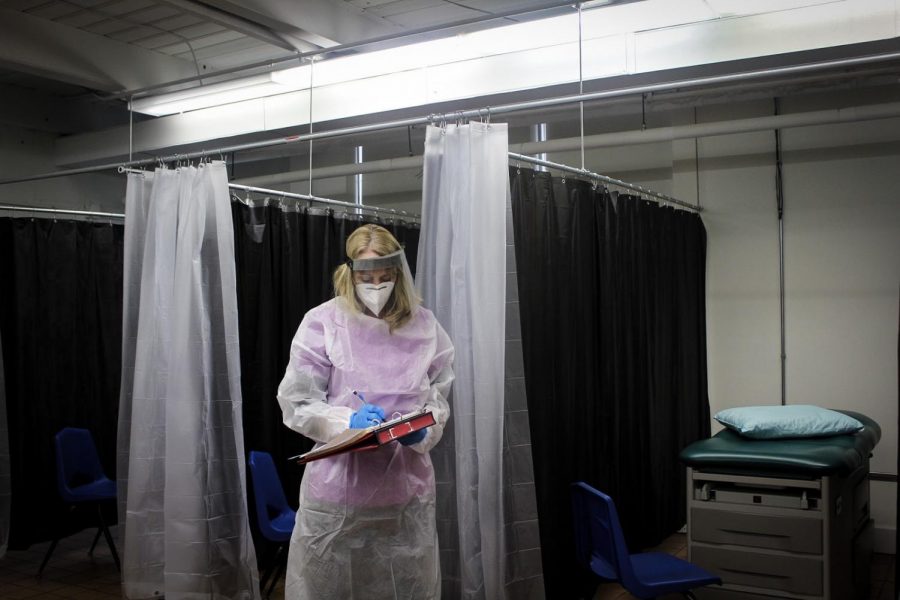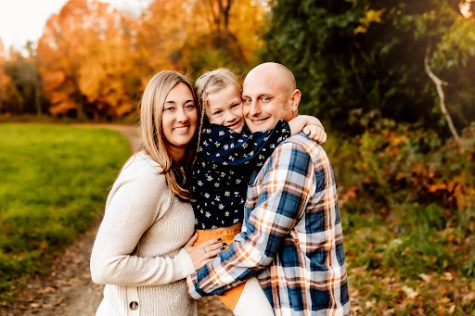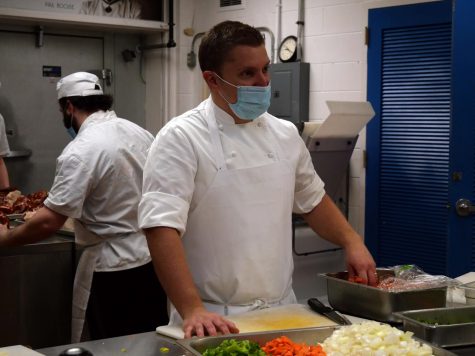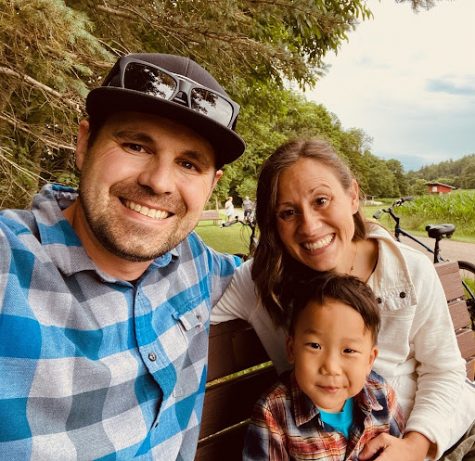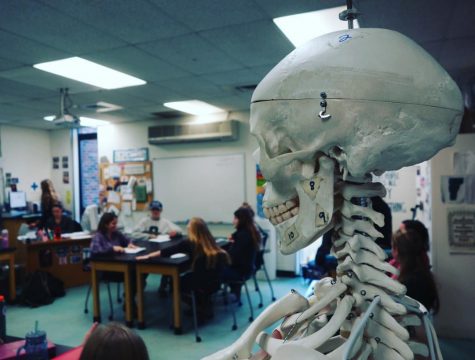Behind the Scenes at BFA: Adapting to a Global Pandemic
BFA Nurse Valarie Lipka stands in the former English Department Office-Turned- Isolation Room Photo Credit: Helen Simmons
February 6, 2021
On July 23, Superintendent Brigid Nease published Harwood Unified Union School District’s reopening plan for the 2020-2021 school year. Nease introduced the plan with a statement on the effects the COVID-19 pandemic has had on children across Vermont. Nease described the challenge school administrators were tasked with on how to bring students together in-person safely without many of the activities that made students enjoy going to school.
“Our administrators are truly losing sleep over making the decisions before us with school opening drawing near. It seems for every problem we solve another one is created. The problem with the guidance being solely based on a medical model focused on transmission is that such information has very little to do with running a school,” Nease explained.
“Physical distancing, obsessive sanitation, mask wearing, PPE, thermometers, isolation rooms, no use of the gym and very little of the playground, breakfast and lunch in classrooms packaged in a box… seriously modified band, music and chorus–this is the fall. Why would we not think students will act out?” she said.
Her letter exploded. Amid ongoing scrutiny from the VT-NEA on the state’s lack of a universal reopening plan for Vermont schools (they “graded” it a D+), teachers and administrators across the state found common ground in Nease’s statement, expressing their frustration over a lack of continuity from district-to-district (and in some cases school-to-school).
VT-NEA president, and former Bellows Free Academy-St. Albans (BFA) English teacher, Donald Tinney, said, “We are increasingly frustrated with the inconsistent and seemingly changing ‘guidance’ from the administration… Instead of joining us in an orderly, phased-in, statewide approach, [Governor Scott] has chosen to allow districts to make critical decisions on their own. Let me be clear: When it comes to the health and safety of students, school employees, and communities, there can be no compromise.”
Brett Blanchard, the new principal of BFA, was one of many administrators with these worries. “I’m reading about the schools down south that opened early and they’re getting crushed by the media. ‘Look at the pile of students! Look at the chaos!’ So there was a certain feeling that people were waiting for failure,” he said. Blanchard started his new position over the summer after leaving his position at Conant High School in New Hampshire.
“There’s a high amount of stress because you’re dealing with such newness in such a high emotional state, which is literally life or death, right? If we do a poor [implementation of] the entryways, some people are seriously going to think this is life or death,” said Blanchard.
One key aspect in the reopening of schools were modifications made to school nurses’ positions. Prior to this school year, students at BFA were assigned one of two school nurses based on last name. Due to COVID-19, students will now go to Nurse Valarie if they are showing symptoms of respiratory illness and Nurse Jodi for daily medications, injuries, or basic first aid. These modifications were made in order to follow the Vermont Strong and Healthy Start guidelines, released by the Vermont Agency of Education and Department of Health over the summer; these guidelines required schools to maintain both a “clean” space and an “isolation” space.
Valarie Lipka, R.N. is this year’s MRUSD COVID Coordinator and is in charge of maintaining BFA’s isolation space. “The purpose of this isolation space is to keep healthy people separate from those who are not feeling well… [When we get a patient,] we find out what their symptoms are, have them put on a KN95 mask, contact the parent and get [the student] home as fast as possible,” Lipka said.
Currently, BFA (along with most middle and high schools in the Champlain Valley) is implementing a 2-3 in-person/virtual hybrid schedule (a fully remote option was offered to families as well). Students have been divided into two groups based on last name to determine whether they are in-person on Mondays and Tuesdays or Thursdays and Fridays. Wednesdays have been reserved as a day for a deep-clean of the campus, while students and teachers remotely check-in for attendance before an opportunity for “office hours.”
“That entailed a reworking of what would be a traditional schedule. Some things you throw out automatically just because it’s going to be too complex [to have] seven periods a day. Then you have to take a look at [maintaining] continuity no matter what step we’re in: step one, virtual; step two, hybrid; step three, in person. We needed a schedule that can transfer and somewhat smoothly [work with] all three,” Blanchard said.
BFA determined the best solution for this was to implement a split-semester schedule. This year, any classes that would have traditionally run for the entire academic year now only run for one semester and previous semester courses now run for one quarter.
After the reopening process has completed, there is one question that remains: how long will it be before K-12 education in Vermont returns to the pre-pandemic normal? In mid-March when Gov. Scott ordered schools to close, we believed we would be back to in-person instruction in just three weeks; now, eleven months in, there is still no sight of a full return-to-normal in the near future. Will the split-semester schedule at the higher grade levels become the new norm? How long will it be before students can go back to eating lunch in the cafeteria with our friends, rather than in our classrooms with the same small number of students?

